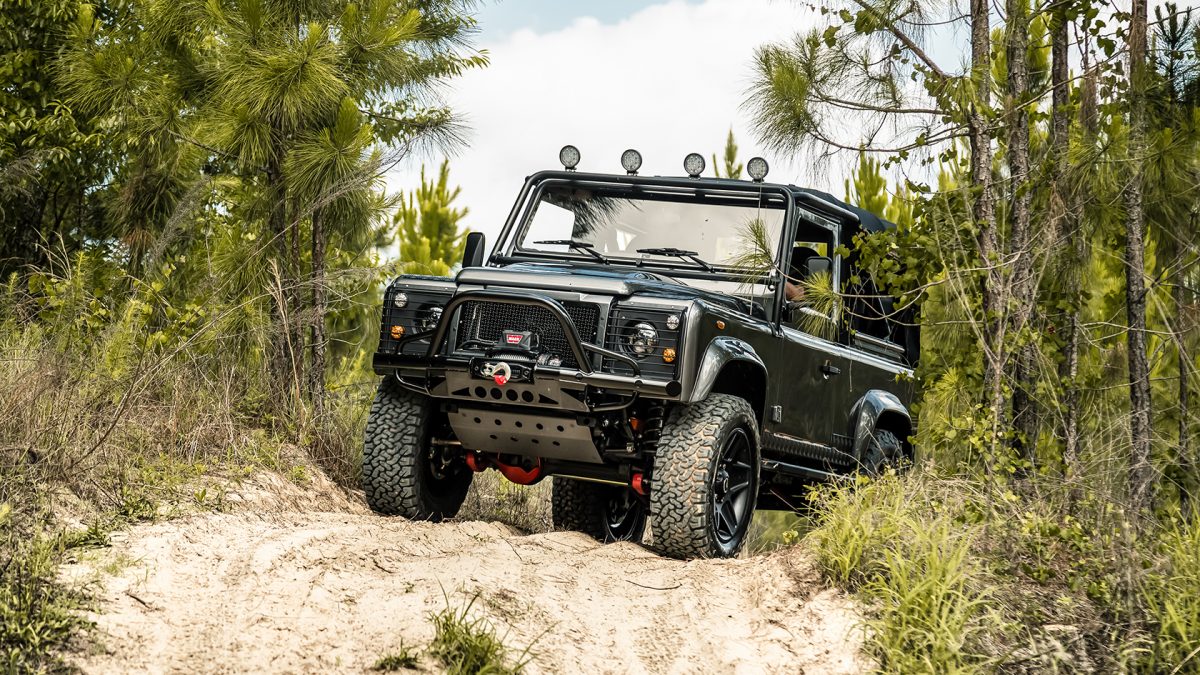Blog
Classic Defender | Evolution of the Legacy Defender

Original Defender Gauges vs Custom Styles | Transforming Your Interior
November 13, 2022
Getting to Know the Jaguar XKE
November 15, 2022The classic Defender lineup was launched in 1983 as the replacement for the Land Rover Series. It’s a capable utility vehicle that became known worldwide as a British off-road icon.
It wasn’t always named the “Defender,” however. In 1983, the first model launched by Land Rover in the range was launched as the “One Ten,” and in 1984, the “Ninety” was launched. There wasn’t much creativity with the names, as they represent the wheelbase length of the vehicles. The 90 and 110 were modernized in comparison to the Series. Mechanical upgrades included coil springs for a more comfortable ride, four-wheel drive, modern interior upgrades, and additional engine options that produced more power than the Series.
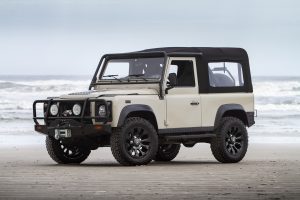
Two Classic Defender Styles | D110 & D90
The classic 90 is a nimble two-door available as a hard-top 4x4 and also as a pick-up truck. The classic 110 is available as a five-door 4x4. Those most commonly used as utility vehicles, the 90 and 110 would be marketed as recreational vehicles as well. The objective was to target a different audience - families. With plenty of space and seating available, it made sense. To entice buyers, minor changes were made to the vehicle, though it would come as a new trim style, the Country 4x4. The biggest change to the 110 for the Country 4x4 was the seats, as they saw an improvement in comfort suitable for families.
The 127 was introduced to the lineup in 1983. It had the front half of a 110 4x4 and the rear half of an extended-length 110. The extra length in between was welded on. The 127 was used mostly for commercial and military. It essentially resembled a “crew cab” version of the 110.
1989 marked the introduction of the Discovery, which prompted a name change in 1990 for the 90, 110, and 127. They were referred to as the “Defender 90,” “Defender 110,” and “Defender 130.” While the 127 was renamed the “Custom Defender 130,” its wheelbase length remained the same.
In 1993, the North American Specification (NAS) Defender, was introduced and available as both a Defender 90 convertible and Defender 110. The NAS Defender was built to meet the safety and emissions standards set forth by the Environmental Protection Agency and the U.S. Department of Transportation. To meet the standards and comply with the regulations, heavy modifications to the Defender had to be completed. Starting with the drivetrain, the NAS Defenders featured a 3.9L V8 engine (Rover V8) paired to a 5-speed manual transmission with upgraded transfer cases. Both the NAS Defender 90 and Defender 110 were fitted with full, external roll cages for safety. Lighting features such as the turn signals and tail lights were enlarged, making them easier to see on the road. Though not related to safety or emissions, the NAS Defenders were only sold in Alpine White.
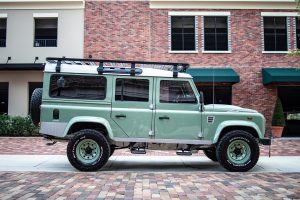 A special edition classic Defender was introduced in 1998, called the Heritage. The Heritage Defender was created as an homage to the beginning of the model range in the 1940s. Offered in only two original colors, dark “Bronze Green” and light “Atlantic Green.”
A special edition classic Defender was introduced in 1998, called the Heritage. The Heritage Defender was created as an homage to the beginning of the model range in the 1940s. Offered in only two original colors, dark “Bronze Green” and light “Atlantic Green.”
Historical Power and Innovation of Classic Defender Builds
The next biggest change to the classic Defender would come in 2007 when the vehicle was required to meet emissions requirements. The “Puma engine” produced 122 horsepower. In addition to the engine, the interior got some modern upgrades as well. The dashboard was upgraded to include a full range of gauges on the instrument cluster. The seating layout also had to be changed to meet safety requirements. This change would remove the inward-facing seats. For the Defender 90, this meant becoming a four-seater vehicle. For the Defender 110, this meant becoming a seven-seater vehicle, reduced from nine seats. At seven seats though, the Defender 110 still provided more seating than the average SUV, which typically only seats five.
In 1994, the NAS Defender 110 was no longer available, leaving only the NAS Defender 90 available in the United States. Since the NAS Defender 110 was no longer available, a “removable hard-top” version of the NAS Defender 90, as well as a regular hard-top 4x4, was released.
1997 marked the end of the NAS Defender 90 due to another change in safety regulations. Although the engine was upgraded and given a 4-speed automatic transmission, the much stricter safety regulations could not be met. New regulations included front driver and passenger-side airbags and side door impact protection.
Production of the classic Defender ceased in 2016. However, it was announced in 2018 that it would be brought back for the 2020 production year. Speculation about the design of the new 2020 Land Rover Defender continues, as it has not yet been fully revealed, though it has been confirmed new models will still keep the Defender 90 and Defender 110 namesake. Unlike the classic Defender, the new 2020 Defender 90 and 2020 Defender 110 names bear no relevance to the length of the wheelbase.
The release of the 2020 Defender leaves many people wondering how it will affect the market for custom Defenders. If anything, we think purists and enthusiasts will be even more drawn to the original classic Defender.
The Difficulties of Restoring a Classic Defender
There’s a reason why car enthusiast blogs and magazines write about restored vehicles like the ones ECD, Arkonik, and Twisted rebuild — it’s because restoring a vintage Defender is f*cking hard! You don’t just wake up one morning and decide to buy a 25+-year-old vehicle and transform it into a jaw-dropping daily driver that amasses a cult following. No. It takes years and years of experience that begins with understanding the complexities of a classic like the Land Rover Defender, and that’s if you can even find one.
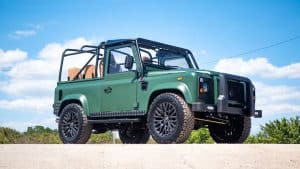
In places, well, unlike pretty much everywhere else in the world, the Defender in North America is a vehicle that’s hard to come by. You might come across one of the rare built-for-America NAS Defenders somewhere, but a 25+-year-old version in original condition that at least runs are an even harder find. Over the course of restoring a classic Defender, you’ll find sourcing for the project, in general, is surprisingly one of the most difficult parts. At times, learning to repair a bulkhead and installing a new engine is like baking a cake with instructions compared to trying to find parts. First, you must source the vehicle, a big enough hump as it is, and then you take on sourcing all of the updated and upgraded parts to repair it; heck, you might even settle for used parts in decent condition (maybe any condition if desperate enough).
Once you’ve figured out your sourcing, understanding a beauty like a Defender is another set of complexities. Some brands, ECD in particular, have learned that it’s best practice to develop a set of blueprints for the Defender over the years. After developing blueprints, they can then take it a step further by creating a guideline for (properly) installing newer parts like a newer wiring harness or a Tesla engine into the original Defender setup. It’s not like you can remove part of the bulkhead to make room for other things. Everything needs a plan and place, and this may be a more frustrating part in restoring a Defender, although when it comes to sorting wiring harnesses, others might find it therapeutic to take time organizing everything carefully. Kind of like building an extremely meticulously detailed model of Air Force One — but life-sized. Installing new engines, AC, and custom features can only be done by someone with years of experience in the craft; no amount of YouTube videos will help you there. The Defender is a majestic beast, and one slip-up means a whole lot of trouble for the go-anywhere vehicle.
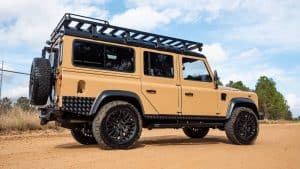 If you plan to choose a completely different style or color for the Defender you have, your project can go either way. If you like the current paint choice and just want a new set of wheels, the switch is relatively easy, and there are plenty of companies that sell aftermarket wheels for the Defender. If you want a whole new color, it’d probably be best to take your vehicle to a professional paint shop (unless you have one on-site like ECD). There, your vehicle’s color can be stripped down, smoothed out, and repainted like it just came from the factory. If you aren’t sure, try ECD’s online Defender builder to test out some colors or look through almost 200 builds of different colors and styles on the company showcase page.
If you plan to choose a completely different style or color for the Defender you have, your project can go either way. If you like the current paint choice and just want a new set of wheels, the switch is relatively easy, and there are plenty of companies that sell aftermarket wheels for the Defender. If you want a whole new color, it’d probably be best to take your vehicle to a professional paint shop (unless you have one on-site like ECD). There, your vehicle’s color can be stripped down, smoothed out, and repainted like it just came from the factory. If you aren’t sure, try ECD’s online Defender builder to test out some colors or look through almost 200 builds of different colors and styles on the company showcase page.
Restoring a classic Defender is difficult, but with experience and about 2,200 man-hours, the rebuild is often enjoyable — especially as the build comes together and is in its final stages of completion. But in the end, nothing beats taking that first drive out on the highway, hitting 60+ mph in a vehicle that was never meant to go that fast, or even still be on the road in America today.

